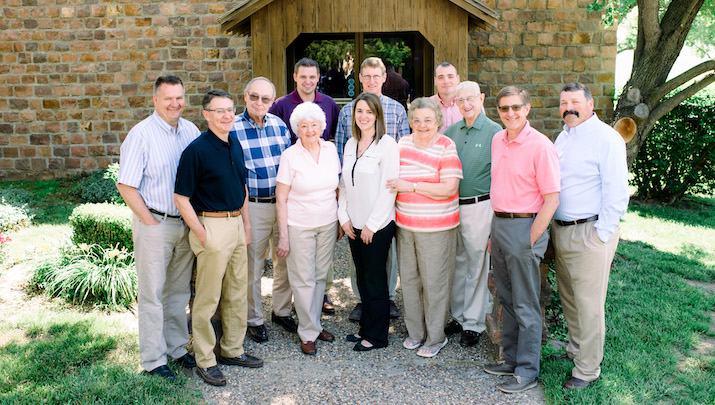

There is No Perfect Recipe for Harmony in Family Business
- Steven Burger
- Burgers' Smokehouse
My family has been selling country ham in central Missouri since the 1920s, when my entrepreneurial grandfather started selling a few country hams for a bit of extra money. He ultimately constructed our original facility, the “Ham House,” in 1952, and with the help and support of his family, the business was launched. My father, along with other G2 family members, built upon that foundation to significantly scale our Evergreen business, Burgers’ Smokehouse. Today, we operate two facilities and employ 350 people, producing a wide variety of cured and smoked meats and other foods for customers throughout the U.S. and southeast Asia.
I am one of nine third- and fourth-generation family members working in the business, and all of us are keenly aware of our role as stewards of a gift that has come to us through the energy and vision of those who came before. Our shared Purpose is to perpetuate the organization to benefit employees and our community and to create value for family shareholders—indefinitely over many generations to come.
For us, remaining privately held is essential to fulfilling that Purpose. We know that as the business grows in size and complexity, opportunities for disharmony will also increase, which could potentially force a sale. As President, I’m charged with implementing structures and guidelines around family ownership and engagement that will help us avoid these pitfalls. I know that tackling family issues head on is essential if we want to be Private forever.
Here are some of the steps we have taken around family ownership and employment to help ensure the success of our Evergreen business. There’s no cookbook or perfect recipe for family harmony and business success, but these steps have been helpful to us as we’ve navigated through transition points and worked to create mileposts for the road ahead.
Family Guidelines
In the mid-eighties, when the G3s started coming on the scene, my dad could see the need for more formal structure around family involvement in and ownership of the company. He went to work creating some of our first family guidelines, which included developing entry and exit guidelines, as well as a formula for our generation to buy stock, based on our relationship to the founder. Those guidelines have continued to evolve and expand and are a living document to help guide the family around a wide range of employment and ownership issues.
Working Outside the Business
Included in the original family guidelines my dad created, was a requirement for family members to work outside the business for a minimum of two years before joining the company. He had the foresight to see that as the company and the family grew, we would need that outside work experience in the next generation. That outside experience has been invaluable and absolutely impacts the way the company is moving forward today. The family members who spend time working in other organizations develop strong skill sets in a variety of areas and come back with life experiences and skills that benefit the company.
Summer Work Program
We have developed a summer work program that really does a good job of helping family self-select whether or not they want to come back to the family business and build a career. Family members can start around age 14-15, and while current labor regulations don’t allow for hands-on work in the plant as was standard in my generation, we offer opportunities for them to work outside the walls of the plant or on our farm, which provides work experience at an early age. It’s not glamorous work—they are painting and weeding and helping check tasks off a list of things that need to be done each summer around our property—but it provides important insight into the company and the scope of our operation.
Family Education
When my dad began developing guidelines, our generation (G3) started meeting as a junior board. We would hear from guest speakers—bankers, insurance experts, other business professionals. My dad also brought in an advisor at that juncture who provided insight into succession and transition issues. We have continued to learn from outside experts, and, just this past year, I hosted a Saturday workshop for family members and presented the family with a comprehensive guidebook that included the guidelines, policies, and procedures that we want family to understand. As we educate family, our aim is to be very intentional about family management and ownership—and that they are different and come with unique rights and responsibilities.
Family Council and Family Board
We’re at an interesting transition with the structure of our family meetings. The Family Council numbered about 15 active members when it was formed in 1994 to build a stronger family and continue refining the guidelines established earlier. In recent years the Family Council has been on autopilot. The family now totals 50 people and counting, rendering a direct democracy too unwieldy to be productive. We are currently developing a Family Board consisting of members representing various branches of the family to review guidelines and plan social events.Recommendations will be brought back to the Family Council. The purpose of the family governance is to address how the family interfaces with the business. Corporate governance is the responsibility of the Corporate Board.
Corporate Board Composition
One of the best things we ever did was include three outside directors on our Corporate Board, which has been really important. I don’t think we’d be where we are today without their influence. The Corporate Board also consists of four family members who work in the company.We are currently strengthening the outside board members’ presence on our salary committee and are using benchmark data to ensure that we’re paying market prices for the positions that family members hold and that those don’t get either inflated or deflated. We may expand the board to nine members by adding another outside member and a representative from the newly formed Family Board.
Seek Out Resources and Advice
For our family, a key to managing family dynamics and guidelines has been to tap into the many resources out there today around these topics. There is a plethora of books and experts and university programs that exist for the perpetuation of family businesses. Know that you are not alone; the challenge you face is nothing that hasn’t been faced by probably every family business in one way or another. Seek out those resources and opportunities. You may also want to consider working with a consultant who has had experience with a lot of different families and can provide best practices for any family business at their particular stage, size, or family dynamic. There are things you do in a start-up family business that you don’t have to concern yourself as you progress through multiple generations. The level of complexity and issues change from generation to generation.
Conclusion
It’s a very gratifying and humbling experience to have a part in passing on a family business from one generation to another. For me, growing up in a second-generation family business, working through the challenges and issues of moving into third generation employment, and now taking the knowledge from 35 years and sharing what I’ve learned with a new generation has stretched me as a business and family leader, but in the end, has been a gift.
Steven Burger is President of Burgers’ Smokehouse.
More Articles and Videos

Both/And Thinking: Harnessing the Positive Potential of Tensions
- Marianne Lewis
- Carl L. Linder College of Business, University of Cincinnati

Leading Through Uncertainty – Tugboat Institute® Summit 2025
- Jackie Hawkins
- Tugboat Institute

Get Evergreen insight and wisdom delivered to your inbox every week
By signing up, you understand and agree that we will store, process and manage your personal information according to our Privacy Policy




